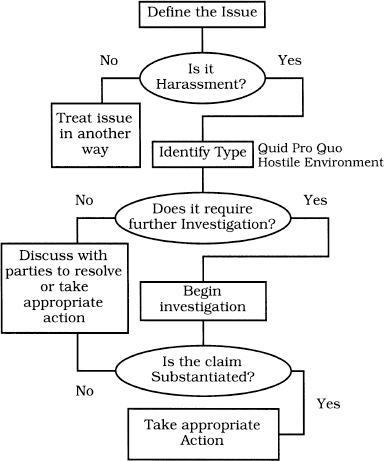The company has four goals in mind as it begins to investigate. It will:
(1) Conduct a confidential investigation.
(2) Consult with those who have knowledge of the alleged harassment.
(3) Consider the evidence in order to come to a rational and supported decision or conclusion.
(4) Correct through “affirmative action” any violation of the company's policy.
The investigation process begins with issue identification. That is, you must first determine if the issue is harassment before you proceed. In an earlier book, The Manager's Pocket Guide to Documenting Employee Performance (HRD Press, 1998), I developed a flowchart to demonstrate the process.
The chart offers four statements and three questions to assist in process fluency. The four statements are:
(2) Identify the type
(3) Begin the investigation
(4) Take appropriate action
The chart asks three basic questions:
(1) Is it harassment?
(2) Does it require further investigation?
(3) Is the claim substantiated?
Each statement and question is designed to take you logically down a path toward a solution. Let's look at an example to see how it works.
| Employee: | Tve been sexually harassed.” |
| Me: | “Would you explain what happened? |
| Employee: | “My supervisor, John, said he would give me a raise if I was nice to him.” |
| Me: | “Did he define, 'nice to him'”? |
| Employee: | “No. But I know what he meant.” |
For the sake of the example, let's leave it at this without further questioning.
The first thing that should pop into your head is something we raised earlier: the phrase perception is reality. This person thinks she was harassed. Therefore, to her way of thinking, it happened. This is enough to warrant an investigation or, at a minimum, enough to ask some questions.
Following the flowchart:
Define the issue: You need to determine the exact meaning behind “nice to him.” It is reasonable to want to find out what the person meant by this stand-alone statement.
Is it harassment? You find through questioning that the answer is no. The alleged harasser claims that he was misunderstood, that he said he was “happy he could give her a raise and that it was nice of her to show her appreciation when he announced it to her.” Others confirm that they didn't take his statement as derogatory or sexually motivated.
Action: Bring the two parties together to resolve or treat the issue in some other way. Face-to-face communication usually works the best.
If the answer is yes, however, identify the type. In this case you determine that it is sexual harassment, quid pro quo, because of the manager's statement as verified by witnesses, “Be nice and I will give you a raise.”
Does it require further investigation? You determine through questioning that the answer is no. (The party may admit to the claim.) So, your action is to “discuss with the parties to resolve or take appropriate action, up to and including termination.”
If the answer is found to be yes, begin the formal investigation. (More on this in a moment.)
Claim substantiated? If the answer is no, we will once again bring the parties together to resolve the claim. If the answer is yes, we take appropriate action.
The point of this simple example is to illustrate that at each stop along the chart, the questions asked and the information gathered will point the investigator in a specific direction. This is a key:
You will find this to be true in most cases. Once the process begins, it will assume a life of its own. All you have to do is be open to it and remember the five rules outlined in Chapter Three.

